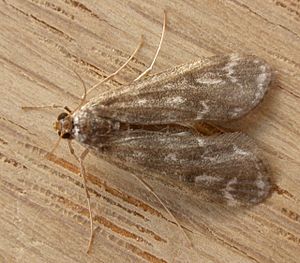Pond moth facts for kids
Quick facts for kids Pond moth |
|
|---|---|
 |
|
| Hygraula nitens photographed in Aranda, Australia | |
| Scientific classification | |
| Kingdom: | |
| Phylum: | |
| Class: | |
| Order: | |
| Family: | |
| Genus: |
Hygraula
|
| Species: |
H. nitens
|
| Binomial name | |
| Hygraula nitens (Butler, 1880)
|
|
| Synonyms | |
|
|
The Hygraula nitens, also known as the pond moth or Australian water moth, is a unique insect. It belongs to the Crambidae family of moths. Arthur Gardiner Butler first identified this species in 1880. You can find the pond moth in New Zealand and most parts of Australia. This includes the island of Tasmania.
About the Pond Moth
The Hygraula nitens is a small to medium-sized moth. Its wingspan is usually about 25 mm (about 1 inch). This makes it easy to spot when it flies around ponds and other water bodies.
Life Cycle: Underwater Larvae
One of the most amazing things about the pond moth is its caterpillars. Unlike most caterpillars, they live completely underwater! These larvae have special body parts that look like tiny threads. These are not hairs, but actually gills. Gills help them breathe oxygen from the water, just like fish do.
The larvae are quite delicate. They build little homes for themselves using pieces of leaves. These leaf houses help protect them while they grow underwater.
What Do They Eat?
The underwater larvae of the pond moth are vegetarians. They feed on different types of aquatic plants. Some of their favorite foods include Potamogeton crispus and Zostera species.
They also eat other non-native aquatic plants. These include Hydrilla verticillata, Lagarosiphon major, and Ceratophyllum demersum. These plants are sometimes brought into new areas by humans.

